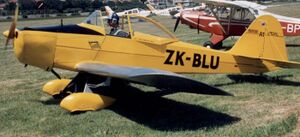Engineering:Andrews A1
| Andrews A1 | |
|---|---|

| |
| The Andrews A1 in 1992 | |
| Role | scale flying test-bed |
| National origin | New Zealand |
| Designer | C.G. Andrews |
| First flight | 1957 |
| Number built | 1 |
| Developed from | Andrews A2 |
The Andrews A1 was a flying ½-scale replica of the un-built Andrews A2 New Zealand agricultural aircraft.
Development
The Andrews A2 was designed by C.G. Andrews in Wellington, New Zealand, intended to compete in the market for a de Havilland Tiger Moth replacement in New Zealand's Aerial Topdressing industry. From the outset it was intended that a ½-scale model of the type be built and flown to prove the design, and this became the Andrews A1.
The Andrews A1 is a conventional low-wing thick-section monoplane of plywood-covered spruce and steel construction with a bubble-type canopy, powered by a 65 hp Continental flat 4 air-cooled engine, and with spatted tailwheel undercarriage.
Operational history
First flown in 1957, the A1 successfully completed flight testing, but by that time the market for the larger Andrews A2 was clearly dominated by the more modern Fletcher Fu24.
The sole Andrews A1, ZK-BLU, was sold to a private owner. It was owned for many years by Alan Rowe, best known as the designer of the Rowe R6b model aircraft, and is now owned by P.G. Alexander of Blenheim, continuing to fly regularly.
Variants
- Andrews A2
- A proposed agricultural aircraft to be optimised for Aerial topdressing.
- Andrews A1
- A flying scale replica of the A2 built to verify aerodynamic qualities and flying characteristics.
Specifications (A1)
General characteristics
- Crew: 1
- Length: 19 ft 0 in (5.8 m)
- Wingspan: 23 ft 11 in (7.3 m)
- Empty weight: 700 lb (317.5 kg)
- Gross weight: 899 lb (408 kg)
- Powerplant: 1 × Continental A65 4-cyl. air-cooled horizontally opposed piston engine, 65 hp (48 kW)
Performance
- Maximum speed: 79 kn (91 mph, 146 km/h)
- Cruise speed: 78 kn (89 mph, 144 km/h)
- Range: 235 nmi (270 mi, 435 km)
Notes
References
 |

